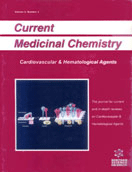Abstract
In the last 15 years, calcium channel blockers have been widely used for treating cardiovascular diseases. These agents are a heterogeneous group of drugs with differing cardiovascular effects, and are effective in the treatment of angina and hypertension. These synthetic compounds bind separately with receptor sites located in or near the calcium channel, at molecular sites still to be fully identified. Verapamil, nifedipine and diltiazem are the most representative calcium channel blockers and used as prototypes for the design and development of new anticalcium molecules with potential efficacy and reduced toxic effects. There are three different types of voltage-operated calcium channels (VOCs): L-type, T-type and N-type, which are considered extra-cellular, but some anti-calcium agents as bepridil possess potential intracellular calcium activity. Many synthetic compounds containing heterocyclic ring in their structures have attracted considerable interest since current studies revealed their mechanisms and sites of action. This article reviews the new advances in the calcium channel antagonist group, showing new structures with longer-acting and higher vascular selectivity.
Keywords: calcium channel antagonists, cardiovascular effects, calcium channel blockers, hypertension, calcium channel, voltage-operated calcium channels
 3
3













